Continental Grand Prix 5000 S TR Comparison: 25, 28, 30, and 32 mm Compared
Contents
- Introduction
- Size, Weight, Thickness Measurements
- Rolling Resistance Test Results
- Puncture Resistance Test Results
- Wet Grip Test Results
- Conclusion
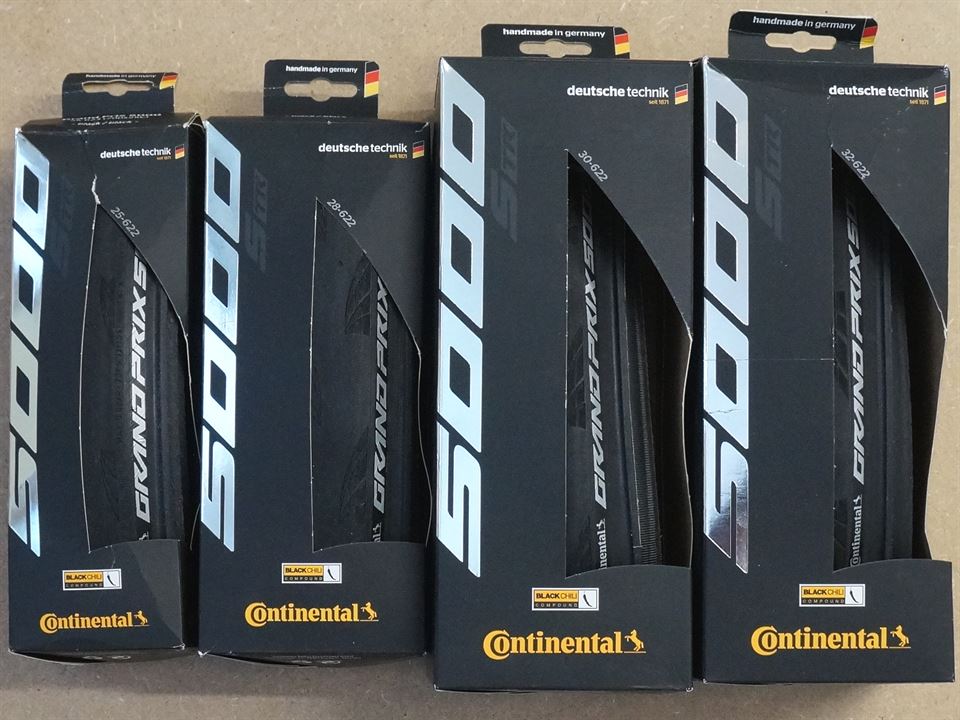
The clincher and tubeless versions of the Continental Grand Prix 5000 have been the most popular road bike tires of the past 3 years. With the new S TR version, Continental introduced a big update to their tubeless version of the Grand Prix 5000. We already tested the 25-622 version a couple of months back and found only limited improvements over the old Grand Prix 5000 TL.
The new Grand Prix 5000 S TR is available in the 25, 28, 30, and 32 mm sizes, and since most people prefer slightly bigger (tubeless) road bike tires these days, we've repeated all our tests on the bigger sizes as well. Many of you probably already read our Grand Prix 5000 23, 25, 28, 32 mm comparison, which focused heavily on rolling resistance tests. This time we've focused less on rolling resistance and made this a more overall comparison with the inclusion of puncture resistance and wet grip tests.
We've also focused more on the expected real-life usage air pressures for these tires. This can make a slight difference in the results as our regular tests are done at slightly different air pressures. The main difference will be in the width and height measurements, as those were normally taken at 100 psi / 6.9 bars for road bike tires.
We were somewhat forced to do it this way as the 30-622 and 32-622 have a relatively low maximum air pressure, even on hooked rims, of just 73 psi / 5.0 bars. If you like to run higher air pressures or are a heavier rider, be aware of this as it might be a problem, especially with the 30-622 version.
Tire Specifications, Size, Weight and Thickness Measurements
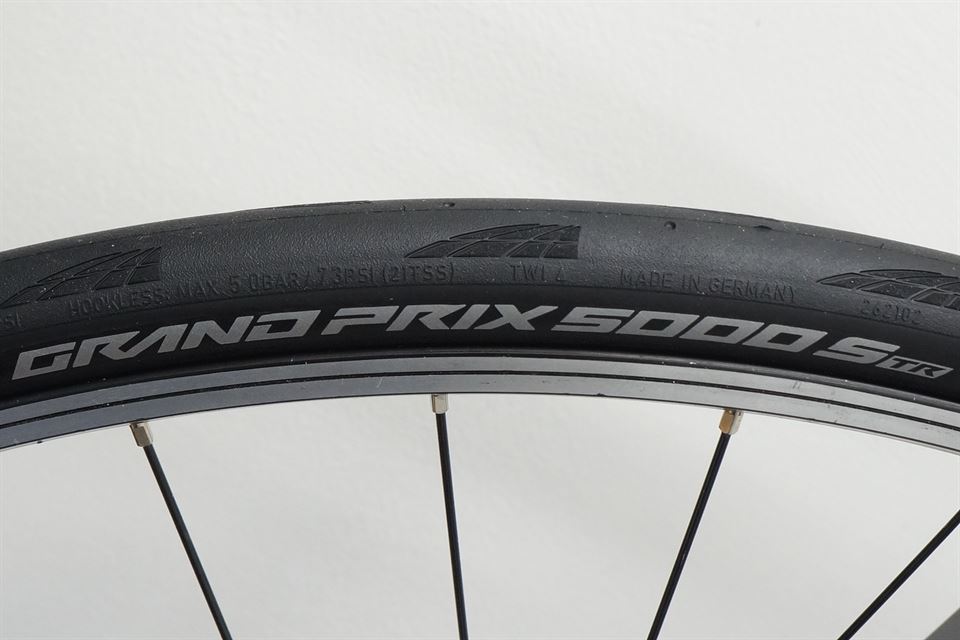
| Weight, Width, Height, and Thickness Measurements | ||||
|---|---|---|---|---|
| Tire | GP 5000 S TR | GP 5000 S TR | GP 5000 S TR | GP 5000 S TR |
| Tire size | 25-622 | 28-622 | 30-622 | 32-622 |
| Manufacturer part number | 0101866 | 0101867 | 0101868 | 0101869 |
| Maximum Air Pressure | 109 psi 7.5 bar |
94 psi 6.5 bar |
73 psi 5.0 bar |
73 psi 5.0 bar |
| Test Air Pressure | 80 psi 5.5 bar |
72 psi 5.0 bar |
69 psi 4.8 bar |
65 psi 4.5 bar |
| Specified weight | 250 grams | 280 grams | 300 grams | 320 grams |
| Measured weight | 255 grams | 266 grams | 292 grams | 310 grams |
| Measured width | 25.3 mm | 28.0 mm | 29.8 mm | 31.4 mm |
| Measured height | 22.1 mm | 25.4 mm | 27.2 mm | 28.8 mm |
| Tread thickness | 2.3 mm | 2.2 mm | 2.2 mm | 2.2 mm |
| Sidewall thickness | 0.90 mm | 0.85 mm | 0.90 mm | 0.85 mm |
| Unmounted Casing Width | 64 mm | 74 mm | 78 mm | 84 mm |
| Unmounted Tread Width | 27 mm | 31 mm | 34 mm | 37 mm |
| Tread to Casing Ratio | 42.2% | 41.9% | 43.6% | 44.0% |
| * Width and height measurements are taken with the tire mounted on a 17.8 mm internal width rim. | ||||
In the simple size and weight measurements, we see that our 25-622 version is a bit heavier than the specified weight, while the bigger versions all come in a bit lighter. Our sample of the 28-622 version even comes in 14 grams lighter than the specified weight and just 11 grams heavier than our 25-622 version. Given the considerable increase in volume the 28-622 provides, that seems like an excellent trade-off.
The higher weight of the 25-622 versions seems to come from a slightly thicker thickness of the tire when compared to the bigger versions, and we expect this to be the manufacturing tolerance.
Given that we've taken all measurements on a 17.8 mm inner width rim, the Grand Prix 5000 S TR seems to be spot on to the specified width. We expect the 25-622 version to be 25.0 mm on a 17c rim, the 28-622 version 28.0 mm on a 18c rim, the 30-622 version 30.0 mm on a 19c rim, and the 32-622 version 32.0 mm on a 20c or 21c rim.
The "Tread to Casing Ratio" seems slightly better on the 30-622 and 32-622 versions. This should be an advantage when using these tires on very wide rims and at very high lean angles.
Test Results
Rolling Resistance Test Results
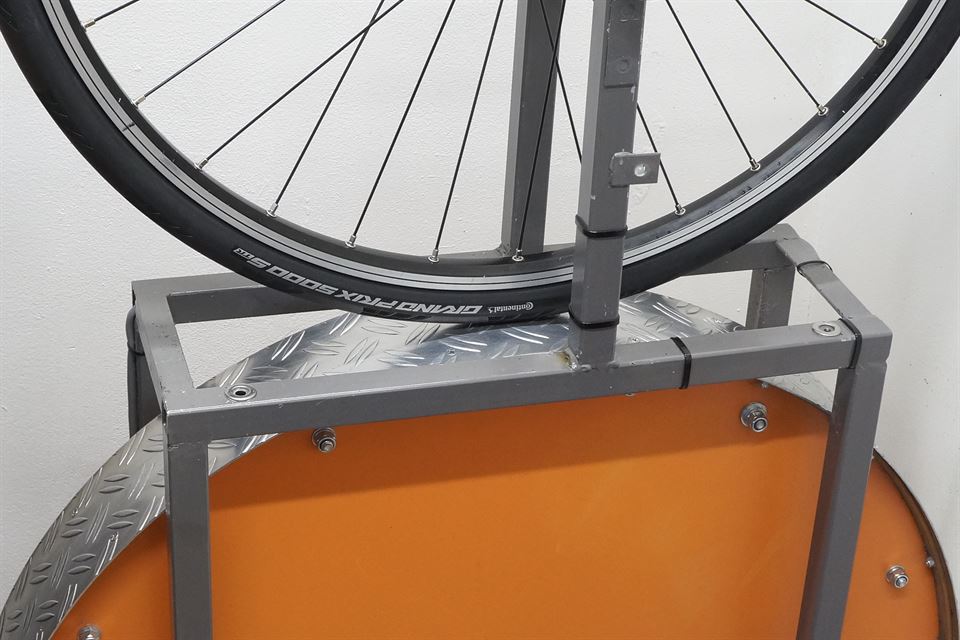
| GP 5000 S TR Rolling Resistance | ||||
|---|---|---|---|---|
| Tire | GP 5000 S TR | GP 5000 S TR | GP 5000 S TR | GP 5000 S TR |
| Tire size | 25-622 | 28-622 | 30-622 | 32-622 |
| Sealant | 20 ml | 22 ml | 24 ml | 26 ml |
| Rolling Resistance 109 psi / 7.5 bar |
8.8 Watts | - | - | - |
| Rolling Resistance 102 psi / 7.0 bar |
9.2 Watts | - | - | - |
| Rolling Resistance 94 psi / 6.5 bar |
9.6 Watts | 9.2 Watts | - | - |
| Rolling Resistance 87 psi / 6.0 bar |
10.0 Watts | 9.6 Watts | - | - |
| Rolling Resistance 80 psi / 5.5 bar |
10.4 Watts | 9.9 Watts | - | - |
| Rolling Resistance 73 psi / 5.0 bar |
11.0 Watts | 10.3 Watts | 9.8 Watts | 9.4 Watts |
| Rolling Resistance 65 psi / 4.5 bar |
11.7 Watts | 10.8 Watts | 10.3 Watts | 9.8 Watts |
| Rolling Resistance 58 psi / 4.0 bar |
12.4 Watts | 11.3 Watts | 10.8 Watts | 10.2 Watts |
| Rolling Resistance 51 psi / 3.5 bar |
- | - | 11.4 Watts | 10.8 Watts |
| All numbers are for a single tire at a speed of 29 km/h / 18 mph and a load of 42.5 kg / 94 lbs. | ||||
As previously mentioned, both the 30-622 and 32-622 versions have a maximum rated air pressure of 73 psi / 5.0 bars, and we've decided to respect those maximum air pressures. The 28-622 version can go up to 94 psi / 6.5 bars which seems like a more usable maximum air pressure for heavier riders.
The rolling resistance results we see above are very much in line with what we've seen in our Grand Prix 5000 23, 25, 28, 32 mm comparison: at the same air pressure, the bigger tires roll faster. The limited maximum air pressures of the bigger sizes of the Grand Prix 5000 S TR complicate things a bit here as the smaller 25-622 version still rolls fastest at its maximum air pressure.
To be clear, we recommend running air pressures of around 80 psi / 5.5 bars on 25-622 road bike tires, average road conditions, and a bike + rider weight of about 85 kg / 187 lbs. For these conditions, the low maximum air pressures should suffice. For very smooth road conditions, you might want to run higher pressures, in which case the 28-622 or 25-622 version would be the better option.
Rolling Resistance Test Results at Recommended Air Pressures
| GP 5000 S TR Rolling Resistance Recommended Air Pressures | ||||
|---|---|---|---|---|
| Tire | GP 5000 S TR | GP 5000 S TR | GP 5000 S TR | GP 5000 S TR |
| Tire size | 25-622 | 28-622 | 30-622 | 32-622 |
| Sealant | 20 ml | 22 ml | 24 ml | 26 ml |
| Measured width | 25.3 mm | 28.0 mm | 29.8 mm | 31.4 mm |
| Air Pressure | 80 psi 5.5 bar |
72 psi 5.0 bar |
69 psi 4.8 bar |
65 psi 4.5 bar |
| Rolling Resistance | 10.4 Watts | 10.2 Watts | 10.0 Watts | 9.8 Watts |
| All numbers are for a single tire at a speed of 29 km/h / 18 mph and a load of 42.5 kg / 94 lbs. | ||||
When adjusting all versions of the Grand Prix 5000 S TR to the recommended air pressures, we see the 32-622 version of the Grand Prix 5000 S TR is the fastest rolling tire. The differences are minimal though, and probably easily offset when also considering the increased weight and higher aerodynamic drag of the bigger tires.
To sum up the rolling resistance tests: the larger versions of the Grand Prix 5000 S TR roll faster, but the differences become minimal when moving to more real-world air pressures.
Puncture Resistance Test Results
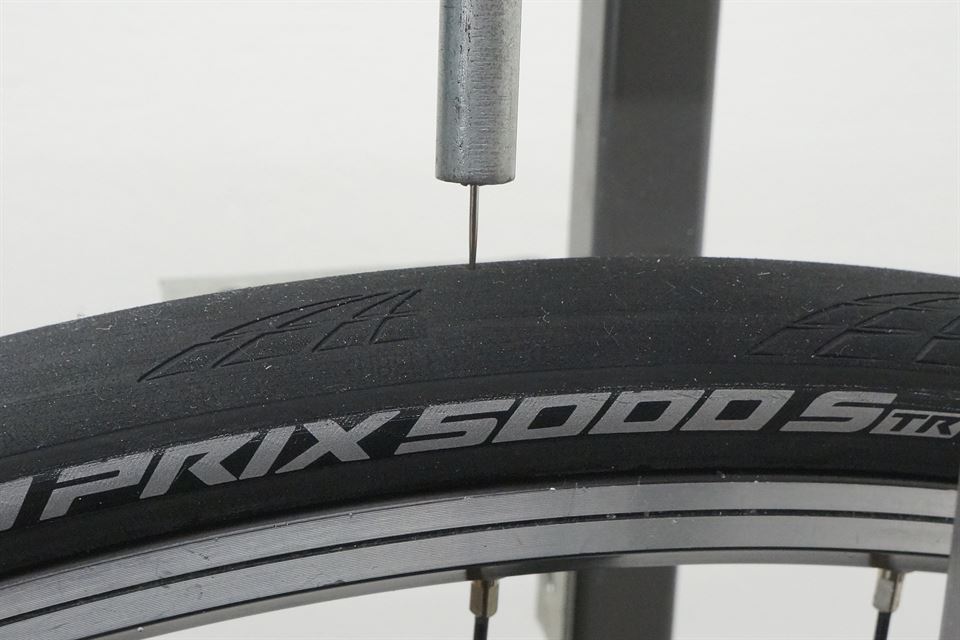
| GP 5000 S TR Puncture Resistance | ||||
|---|---|---|---|---|
| Tire | GP 5000 S TR | GP 5000 S TR | GP 5000 S TR | GP 5000 S TR |
| Tire size | 25-622 | 28-622 | 30-622 | 32-622 |
| Air Pressure | 80 psi 5.5 bar |
72 psi 5.0 bar |
69 psi 4.8 bar |
65 psi 4.5 bar |
| Total Puncture Score Tread | 36 Points | 36 Points | 36 Points | 34 Points |
| Total Puncture Score Sidewall | 17 Points | 16 Points | 17 Points | 16 Points |
As the construction of all the different sizes of the Grand Prix 5000 S TR is the same, we're not expecting any differences in the puncture resistance tests. The only thing that could make a difference would be the different air pressures, as we've used the recommended air pressures here as well.
The test results show the 32-622 performs a bit worse in the puncture tests, with the smaller versions performing nearly identical. As there isn't a clear pattern to be seen in the test results, and we never noticed big differences in previous tests, we attribute the lower score of the 32-622 to the test's margin of error.
As these are tubeless tires filled with sealant, the bigger tires should have an advantage in real-life puncture resistance and re-sealing capabilities. As the real-life air pressure of the bigger tires is lower, the sealant will re-seal the puncture faster as the sealing capability is highly dependent on the air pressure. Another advantage of the bigger tires is a bigger "air reservoir" that can seal the hole before the tire pressure becomes unrideable low.
Wet Grip Test Results
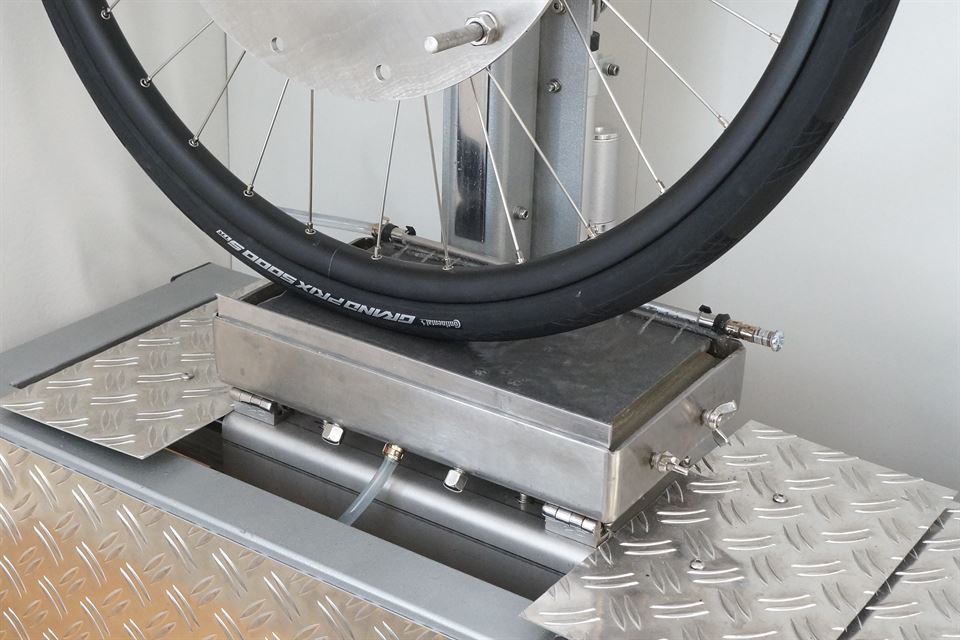
| Static Grip Test Results (higher is better) | ||||
|---|---|---|---|---|
| Tire | GP 5000 S TR | GP 5000 S TR | GP 5000 S TR | GP 5000 S TR |
| Tire size | 25-622 | 28-622 | 30-622 | 32-622 |
| Air Pressure | 80 psi 5.5 bar |
72 psi 5.0 bar |
69 psi 4.8 bar |
65 psi 4.5 bar |
| Wet Grip Average | 66 Points | 67 Points | 68 Points | 71 Points |
| Wet Grip Center | 67 Points | 68 Points | 69 Points | 72 Points |
| Wet Grip Edge | 65 Points | 67 Points | 67 Points | 69 Points |
We see a clear pattern in the wet grip tests: the bigger tires provide more grip.
As the wet grip test is still new for us, and we have limited experience with different tire pressures, we also tested the 32-622 Grand Prix 5000 S TR at 80 psi / 5.5 bar to see how that would affect the grip in our test.
When examining the results of the 32-622 at 65 psi and 80 psi, we see grip drops down a bit at the higher air pressure, but it's still better than the 25-622 version at the same air pressure.
From the combined results, we would conclude that bigger tires have better grip, and lower air pressures also increase grip. This is a double advantage for the bigger tires, so if you value grip, bigger seems better.
We wouldn't be surprised if this advantage becomes even more significant in real-life, at higher speeds and more uneven road surfaces.
Conclusion
We've made a lot of comparisons of different sizes of the same tire by now, but the Grand Prix 5000 S TR comparison is the first time we compared tubeless road bike tires.
We still see many similarities with our previous comparisons, and it's clear that the bigger versions of the Grand Prix 5000 S TR offer some advantages over the smaller versions. We feel that some things become more important with tubeless road bike tires, which might tip the scale towards the bigger sizes.
At the same air pressures, the bigger sizes of the Grand Prix 5000 have a lower rolling resistance which isn't that surprising as we've seen the same thing in our previous comparisons. When moving to the "recommended air pressures", we still see the bigger versions rolling a bit faster, although the difference will be hard to notice in real-life.
The real value of the bigger sizes of tubeless road bike tires lies in the better real-life puncture resistance because of better re-sealing at lower air pressures and a bigger "air reservoir" that can be used to re-seal the tire before reaching an unrideable low air pressure.
Our grip test also indicates the bigger tires at lower air pressures provide more grip even on our flat textured surface at very low speeds. We expect the difference to become even bigger at higher speeds and more uneven road surfaces.
In the case of the Grand Prix 5000 S TR, we always recommend picking the 28-622 version over the 25-622 version. In our opinion, the 25-622 versions of new road bike tires have been downsized too much, and they are now close to the size of 23-622 tires from a couple of years ago. Going even bigger than the 28-622 might be even better, but it will depend a lot on your personal preferences.
